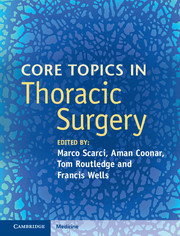Book contents
- Frontmatter
- Contents
- List of contributors
- Section I Diagnostic work-up of the thoracic surgery patient
- Section II Upper airway
- Section III Benign conditions of the lung
- Section IV Malignant conditions of the lung
- 11 Evaluation of solitary pulmonary nodule
- 12 Lung cancer staging
- 13 Pathological considerations in lung malignancy
- 14 Medical treatment of lung cancer (neo and adjuvant chemoradiotherapy)
- 15 Superior vena cava obstruction: etiology, clinical presentation and principles of treatment
- 16 Robotics in thoracic surgery
- 17 Pulmonary metastasectomy
- Section V Diseases of the pleura
- Section VI Diseases of the chest wall and diaphragm
- Section VII Disorders of the esophagus
- Section VIII Other topics
- Index
- References
17 - Pulmonary metastasectomy
from Section IV - Malignant conditions of the lung
Published online by Cambridge University Press: 05 September 2016
- Frontmatter
- Contents
- List of contributors
- Section I Diagnostic work-up of the thoracic surgery patient
- Section II Upper airway
- Section III Benign conditions of the lung
- Section IV Malignant conditions of the lung
- 11 Evaluation of solitary pulmonary nodule
- 12 Lung cancer staging
- 13 Pathological considerations in lung malignancy
- 14 Medical treatment of lung cancer (neo and adjuvant chemoradiotherapy)
- 15 Superior vena cava obstruction: etiology, clinical presentation and principles of treatment
- 16 Robotics in thoracic surgery
- 17 Pulmonary metastasectomy
- Section V Diseases of the pleura
- Section VI Diseases of the chest wall and diaphragm
- Section VII Disorders of the esophagus
- Section VIII Other topics
- Index
- References
Summary
Introduction
Pulmonary metastasectomy refers to the surgical excision of metastasis to the lung originating from an extrathoracic location. Pulmonary metastases can potentially develop in any malignant tumor with a prevalence of 30% in patients diagnosed with cancer. The pathophysiology of pulmonary metastases is thought to result from the dissemination of tumor cells from the primary tumor site to the blood circulation. These cells are stopped in the pulmonary capillary bed, and if they have the capacity, develop new tumor entities called metastasis. Histologic studies have demonstrated that 84% of pulmonary metastases receive their blood supply from the pulmonary arteries, while 16% receive it exclusively from bronchial arteries. The probability of a new lung lesion being a metastasis is directly related to the original primary tumor. In situations of sarcoma or melanoma primary tumors, the likelihood of a new lung nodule being metastasis is approximately 80%. If the primary tumor is urothelial or colorectal, the likelihood of a new lung nodule being metastatic is 50%. Interestingly, in situations of head and neck cancer, a new pulmonary nodule is twice as likely to be a primary tumor rather than a metastasis. The latter is mostly explained by the exposure to tobacco. For these reasons, the histologic analysis of pulmonary nodules should be performed preoperatively or intraoperatively to determine the surgical strategy of resection. Fineneedle aspiration biopsy can sometimes be a good alternative; however, this approach does not always yield enough material to differentiate primary lung cancer from lung metastasis of colorectal or breast cancer.
Rationale for curative pulmonary metastasectomy
The management of the majority of patients who develop lung metastases is generally palliative including chemotherapy due to the metastatic invasion of other organs. The resection of pulmonary metastases is sometimes indicated for palliation in situations of pain due to chest wall invasion, massive hemoptysis or retention pneumonia due to centrally located metastases. However, more important, a substantial group of patients with pulmonary metastases may benefit from resection of lung metastases with curative intent. Although there are no prospectively randomized studies comparing pulmonary metastasectomy with chemotherapy or observation, surgical resection of pulmonary metastases is widely performed in carefully selected patients.
- Type
- Chapter
- Information
- Core Topics in Thoracic Surgery , pp. 167 - 178Publisher: Cambridge University PressPrint publication year: 2016



